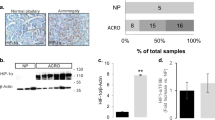Abstract
Estrogen receptor α has a role in regulating rat somatolactotroph tumor cell growth (GH3 cells). AMP-activated protein kinase (AMPK) is a metabolic checkpoint which is able to negatively regulate intracellular signaling downstream of growth factors receptors in conditions increasing cellular AMP levels. We have recently reported on the role of AMPK activation in affecting viability and proliferation of GH3 cells. In the present study, we investigated the interplay between ER- and AMPK-pathways. Results can be regarded as relevant to the development of novel multi-targeted pharmacological therapies against pituitary tumors. We confirmed that estradiol (E2) and the ER antagonist fulvestrant exert stimulatory and inhibitory effects, respectively on GH3 cell growth in a competitive manner. The upstream kinase LKB1 is known to phosphorylate and activate AMPK. Here we showed that neither E2 nor fulvestrant caused a downregulation of LKB1 expression and phospho-AMPK levels in GH3 cells. Actually, fulvestrant strongly reduced the phosphorylation of ACC, which is a direct target of AMPK and a known index of AMPK activity. 2-deoxyglucose, a compound reducing glucose utilization, caused an increase in AMPK activity vs baseline and was able to hinder the stimulatory effect of E2 on cell viability, confirming that the exposure of GH3 cells to estrogens does not prevent them from being responsive to the inhibitory activity of compounds activating AMPK. Finally, the AMPK activator AICAR (AMP analog) did not cause further decrease in cell viability in the course of co-treatments with fulvestrant versus fulvestrant alone, in agreement with impaired phospho-AMPK activity in the presence of the anti-estrogen.




Similar content being viewed by others
References
Newton CJ (1995) Estrogen blockade by the pure antiestrogen ZM 182730 induces death of pituitary tumor cells. J Ster Biochem Mol Biol 55:327–336
Kansra S, Chen S, Bangaru MLY, Sneade L, Dunckley JA, Ben-Jonathan N (2010) Selective estrogen receptor down-regulator and selective estrogen receptor modulators differentially regulate lactotroph proliferation. PLoS ONE 5(4):e10060
Hawley SA, Boudeau J, Reid JL, Mustard KJ, Udd L, Mäkelä TP, Alessi DR, Hardie DG (2003) Complexes between the LKB1 tumor suppressor, STRAD alpha/beta and MO25 alpha/beta are upstream kinases in the AMP-activated protein kinase cascade. J Biol 2:28
Woods A, Johnstone SR, Dickerson K, Leiper FC, Fryer LG, Neumann D, Schlattner U, Wallimann T, Carlson M, Carling D (2003) LKB1 is the upstream kinase in the AMP-activated protein kinase cascade. Curr Biol 13:2004–2008
Hardie DG (2007) AMP-activated/SNF1 protein kinases: conserved guardians of cellular energy. Nat Rev Mol Cell Biol 8:774–785
Towler MC, Hardie GD (2007) AMP-Activated protein kinase in metabolic control and insulin signaling. Circ Res 100:328–341
Motoshima H, Goldstein BJ, Igata M, Araki E (2006) AMPK and cell proliferation—AMPK as a therapeutic target for atherosclerosis and cancer. J Physiol 574:63–71
Park HU, Suy S, Danner M, Dailey V, Zhang Y, Li H, Hyduke DR, Collins BT, Gagnon G, Kallakury B, Kumar D, Brown ML, Fornace A, Dritschilo A, Collins SP (2009) AMP-activated protein kinase promotes human prostate cancer cell growth and survival. Mol Cancer Ther 8:733–741
Brown KA, McInnes KJ, Takagi K, Ono K, Hunger NI, Wang L, Sasano H, Simpson ER (2011) LKB1 expression is inhibited by estradiol 17-beta in MCF-7 cells. J Ster Biochem Mol Biol 127:439–443
Tulipano G, Giovannini M, Spinello M, Sibilia V, Giustina A, Cocchi D (2011) AMP-activated protein kinase regulates normal rat somatotroph cell function and growth of rat pituitary adenomatous cells. Pituitary 14:242–252
Tulipano G, Faggi L, Losa M, Mortini P, Spinello M, Sibilia V, Pagani F, Cocchi D, Giustina A (2013) Effects of AMPK activation and combined treatment with AMPK activator and somatostatin on hormone secretion and cell growth in cultured GH-secreting pituitary tumor cells. Mol Cell Endocrinol 365:167–206
Miller M, Chen S, Woodliff J, Kansra S (2008) Curcumin (diferuloylmethane) inhibits cell proliferation, induces apoptosis, and decreases hormone levels and secretion in pituitary tumor cells. Endocrinology 149:4158–4167
Vega-Avila E, Pugsley MK (2011) An overview of colorimetric assay methods used to assess survival or proliferation of mammalian cells. Proc West Pharmacol Soc 54:10–14
Tulipano G, Bonfanti C, Poiesi C, Burattin A, Turazzi S, Barone G, Cozzi R, Bollati A, Valle D, Giustina A (2004) Effects of the selective estrogen receptor modulator LY117018 on growth hormone secretion: in vitro studies. Metabolism 53:563–570
Lim CT, Kola B, Korbonits M (2009) AMPK as a mediator of hormonal signalling. J Mol Endocrinol 44:87–97
Tulipano G, Faggi L, Sibilia V, Giustina A (2012) Points of integration between the intracellular energy sensor AMP-activated protein kinase (AMPK) activity and the somatotroph axis function. Endocrine 42:292–298
Bénéteau M, Zunino B, Jacquin MA, Meynet O, Chiche J, Pradelli LA, Marchetti S, Cornille A, Carles M, Ricci JE (2012) Combination of glycolysis inhibition with chemotherapy results in an antitumor immune response. Proc Natl Acad Sci USA 109:20071–20076
Tomas E, Tsao TS, Saha AK, Murrey HE, Zhang CC, Itani SI, Lodish HF, Ruderman NB (2002) Enhanced muscle fat oxidation and glucose transport by ACRP30 globular domain: acetyl-CoA carboxylase inhibition and AMP-activated protein kinase activation. Proc Natl Acad Sci USA 99:16309–16313
Guo D, Cloughesy TF, Radu CG, Mischell PS (2010) AMPK: a metabolic checkpoint that regulates the growth of EGFR activated glioblastomas. Cell Cycle 9:211–212
Acknowledgments
This work was supported by local funds (2011–2012) from the University of Brescia to G. T. and D. C and funds from the Center for Research in Osteoporosis and Bone Metabolism, University of Brescia (A. G.).
Conflict of interest
L. F., A. C., D. C. and G. T. have nothing to disclose. M. S is employed by Novartis Farma SpA, (Origgio, Italy) and A. G. has received consulting and lecture fees form Ipsen, Novartis and Pfeizer.
Author information
Authors and Affiliations
Corresponding author
Rights and permissions
About this article
Cite this article
Tulipano, G., Faggi, L., Cacciamali, A. et al. Interplay between the intracellular energy sensor AMP-activated protein kinase (AMPK) and the estrogen receptor activities in regulating rat pituitary tumor cell (GH3) growth in vitro. Pituitary 17, 203–209 (2014). https://doi.org/10.1007/s11102-013-0488-y
Published:
Issue Date:
DOI: https://doi.org/10.1007/s11102-013-0488-y




